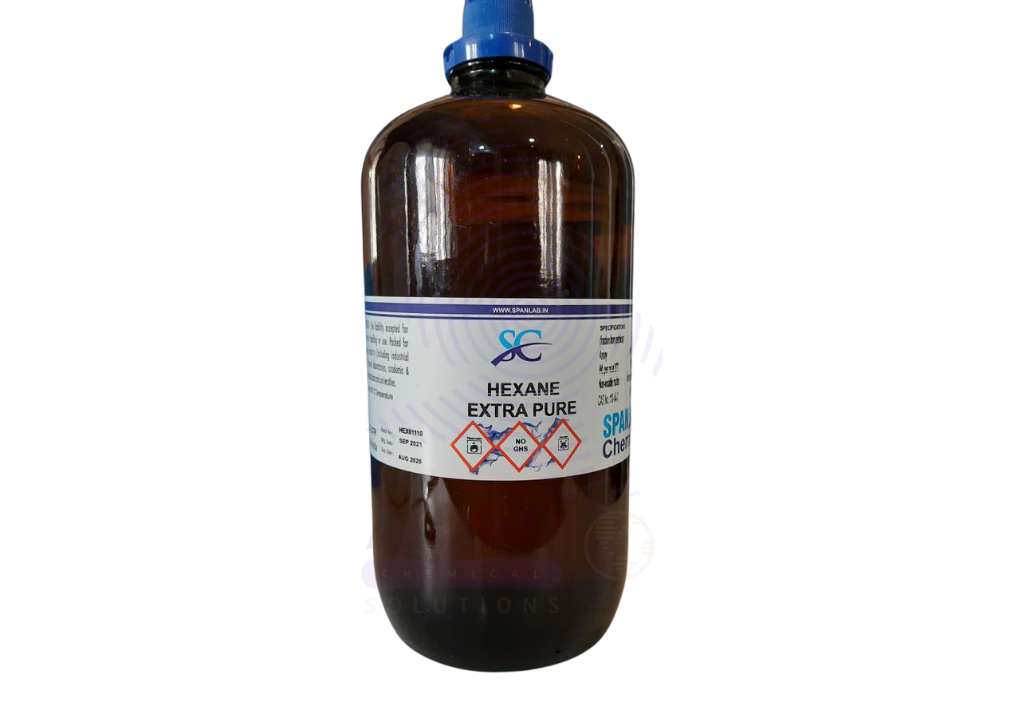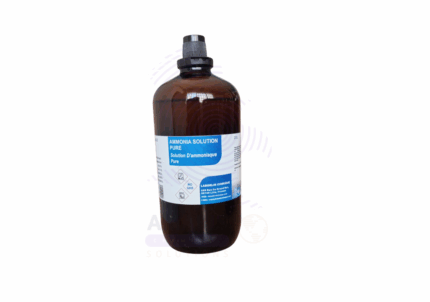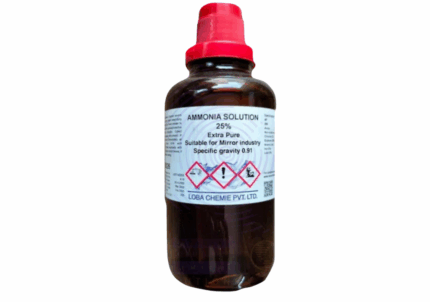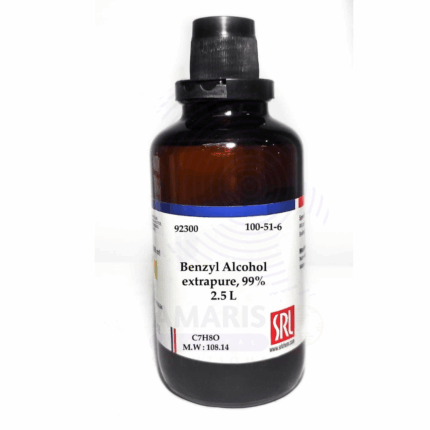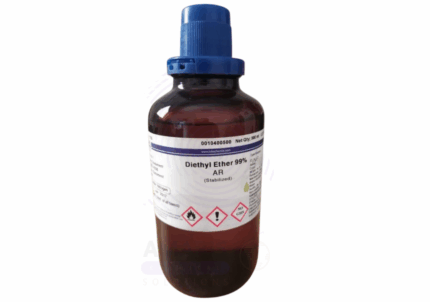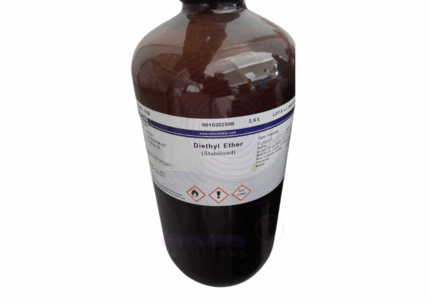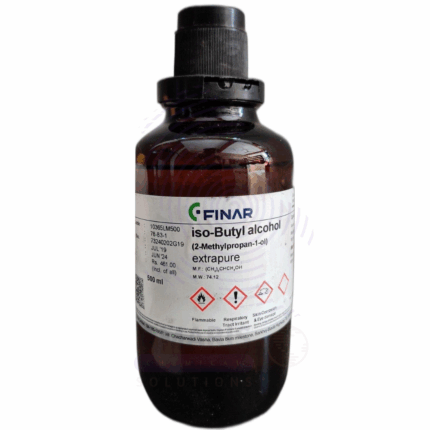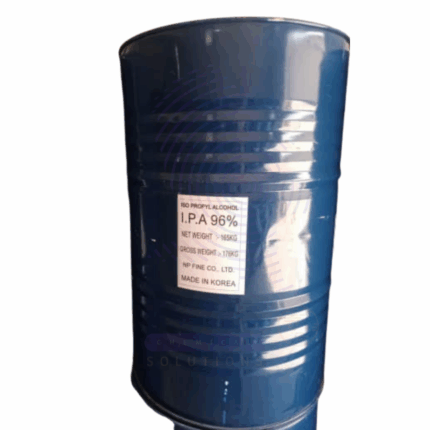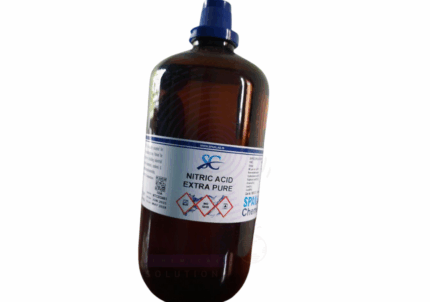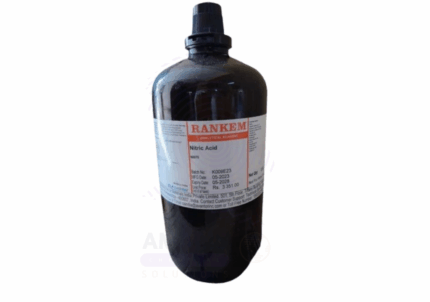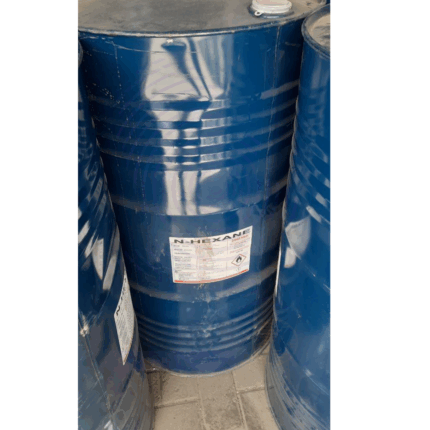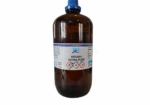
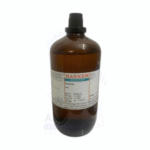

Hexane Extra Pure
$ 30.00 Original price was: $ 30.00.$ 29.87Current price is: $ 29.87.
Hexane Extra Pure is a high-purity, colorless liquid hydrocarbon known for its low boiling point and excellent solvency properties. It is extensively used in laboratories as a non-polar solvent for extractions, chromatography, and purification processes. Due to its volatility and ability to dissolve oils and fats, hexane is also employed in the preparation of samples for analysis, especially in organic chemistry and analytical laboratories. Its extra pure grade ensures minimal impurities, making it suitable for critical applications in pharmaceutical research, food testing, and industrial quality control.
Hexane Extra Pure
Primary Uses
- Non-polar solvent in organic extractions:
Widely used to extract oils, lipids, and other non-polar compounds from plant or animal materials in biochemical and organic chemistry labs. - Chromatographic solvent:
Commonly employed as the mobile phase in thin-layer chromatography (TLC) and column chromatography for separating non-polar analytes.
Secondary Uses
- Cleaning and degreasing agent in analytical setups:
Utilized to remove oily residues or organic contaminants from laboratory glassware and instruments. - Volatile medium for recrystallization of hydrophobic compounds:
Used in purification protocols where controlled evaporation helps isolate non-polar substances. - Diluent for hydrophobic reagents or standards:
Acts as a carrier or diluting agent for certain laboratory standards in GC (gas chromatography) and preparative work.
| PACK SIZE |
2.5 Litres Glass bottle |
|---|
1. Basic Identification Attributes
- Chemical Name: Hexane
- Other Names: n-Hexane, Normal Hexane
- Chemical Formula: C₆H₁₄
- CAS Number: 110-54-3
- Molecular Weight: 86.18 g/mol
- Grade: Extra Pure (Laboratory/Reagent Grade)
- Appearance: Colorless liquid
- Odor: Gasoline-like odor
2. Physical & Chemical Properties
- Boiling Point: 68–70 °C
- Melting Point: -95 °C
- Density: 0.66 g/cm³ at 20 °C
- Solubility:
- Insoluble in water
- Soluble in alcohol, ether, acetone
- Vapor Pressure: ~124 mmHg at 25 °C
- Flash Point: -22 °C (closed cup)
- Autoignition Temperature: 234 °C
- Explosive Limits: 1.1% – 7.5% (in air)
3. Safety & Hazard Attributes
- GHS Classification:
⚠️ Flammable Liquid (Category 2)
⚠️ Specific Target Organ Toxicity – Repeated Exposure (Category 2)
⚠️ Aspiration Hazard (Category 1)
⚠️ Acute Toxicity (Category 4 – inhalation) - Hazard Statements:
- H225: Highly flammable liquid and vapor
- H304: May be fatal if swallowed and enters airways
- H336: May cause drowsiness or dizziness
- H373: May cause damage to nervous system through prolonged exposure
- PPE Requirements:
- Flame-resistant lab coat
- Chemical-resistant gloves (e.g., nitrile)
- Safety goggles
- Fume hood use is strongly recommended
- First Aid Measures:
- Inhalation: Move to fresh air immediately; seek medical attention if symptoms persist
- Skin Contact: Wash thoroughly with soap and water
- Eye Contact: Rinse cautiously with water for several minutes
- Ingestion: Do NOT induce vomiting; seek immediate medical attention
4. Storage & Handling Attributes
- Storage Conditions:
- Store in a cool, well-ventilated area away from heat and ignition sources
- Keep container tightly closed
- Use only non-sparking tools
- Ground and bond containers during transfer
- Handling Notes:
- Always handle under a fume hood
- Avoid inhalation of vapors
- Prevent static discharge buildup
5. Regulatory & Compliance Attributes
- DOT/ADR Classification: Flammable Liquid
- IATA Classification: UN 1208, Class 3 (Flammable liquid)
- Labeling Requirements: GHS pictograms for flame and health hazard
- VOC Content: Regulated in many jurisdictions
6. Laboratory Applications
- Primary Uses:
- Non-polar solvent in organic synthesis and extraction
- Sample preparation for chromatography (especially GC)
- Cleaning agent for lab glassware
- Secondary Uses:
- Diluent for oil and grease testing
- Solvent for rubber and polymer processing research
- Carrier solvent in pesticide formulation experiments
SAFETY PRECAUTIONS
Personal Protective Equipment (PPE):
- Wear a lab coat, chemical-resistant nitrile gloves, and protective goggles.
- Use a properly functioning fume hood or respirator to avoid inhalation.
Handling:
- Avoid contact with skin, eyes, and clothing.
- Keep away from heat, sparks, open flames, and hot surfaces.
- Avoid inhaling vapors and ensure good ventilation.
- Ground and bond containers when transferring material.
Storage:
- Store in a cool, dry, and well-ventilated area away from direct sunlight.
- Keep the container tightly closed.
- Store away from oxidizing agents, acids, and ignition sources.
FIRST AID MEASURES
Inhalation:
- Move the person to fresh air immediately.
- If breathing is difficult, provide oxygen and seek medical attention.
- If not breathing, begin artificial respiration.
Skin Contact:
- Remove contaminated clothing.
- Wash affected areas with soap and water.
- Seek medical attention if irritation develops.
Eye Contact:
- Rinse cautiously with water for at least 15 minutes.
- Remove contact lenses if present and easy to do.
- Seek immediate medical attention.
Ingestion:
- Do not induce vomiting.
- Rinse your mouth thoroughly with water.
- Seek immediate medical attention.
FIRE FIGHTING MEASURES
Flammability:
- Highly flammable liquid and vapor.
- Vapors may form explosive mixtures with air.
Extinguishing Media:
- Use dry chemical, alcohol-resistant foam, carbon dioxide (CO₂), or water spray.
- Do not use a direct water jet.
Hazardous Combustion Products:
- May emit carbon monoxide and carbon dioxide upon combustion.
Firefighter Protection:
- Wear full protective gear and a self-contained breathing apparatus (SCBA).
- Cool containers with water spray to prevent pressure build-up and explosion.


 Preservatives(food)
Preservatives(food) Flavor Enhancers
Flavor Enhancers Acidulants
Acidulants Sweeteners
Sweeteners Antioxidants
Antioxidants Colorants(food)
Colorants(food) Nutraceutical Ingredients (food)
Nutraceutical Ingredients (food) Nutrient Supplements
Nutrient Supplements Emulsifiers
Emulsifiers
 Collectors
Collectors Dust Suppressants
Dust Suppressants Explosives and Blasting Agents
Explosives and Blasting Agents Flocculants and Coagulants
Flocculants and Coagulants Frothers
Frothers Leaching Agents
Leaching Agents pH Modifiers
pH Modifiers Precious Metal Extraction Agents
Precious Metal Extraction Agents
 Antioxidants(plastic)
Antioxidants(plastic) Colorants (Pigments, Dyes)
Colorants (Pigments, Dyes) Fillers and Reinforcements
Fillers and Reinforcements Flame Retardants
Flame Retardants Monomers
Monomers Plasticizers
Plasticizers Polymerization Initiators
Polymerization Initiators Stabilizers (UV, Heat)
Stabilizers (UV, Heat)
 Antifoaming Agents
Antifoaming Agents Chelating Agents
Chelating Agents Coagulants and Flocculants
Coagulants and Flocculants Corrosion Inhibitors
Corrosion Inhibitors Disinfectants and Biocides
Disinfectants and Biocides Oxidizing Agents
Oxidizing Agents pH Adjusters
pH Adjusters Scale Inhibitors( water)
Scale Inhibitors( water)
 Antioxidants(cosmetic)
Antioxidants(cosmetic) Emollients
Emollients Fragrances and Essential Oils
Fragrances and Essential Oils Humectants
Humectants Preservatives
Preservatives Surfactants(cosmetic)
Surfactants(cosmetic) Thickeners
Thickeners UV Filters
UV Filters
 Fertilizers
Fertilizers Soil Conditioners
Soil Conditioners Plant Growth Regulators
Plant Growth Regulators Animal Feed Additives
Animal Feed Additives Biostimulants
Biostimulants Pesticides (Herbicides, Insecticides, Fungicides)
Pesticides (Herbicides, Insecticides, Fungicides)
 Active Pharmaceutical Ingredients (APIs)
Active Pharmaceutical Ingredients (APIs) Excipients
Excipients Solvents(pharmaceutical)
Solvents(pharmaceutical) Antibiotics
Antibiotics Antiseptics and Disinfectants
Antiseptics and Disinfectants Vaccine Adjuvants
Vaccine Adjuvants Nutraceutical Ingredients (pharmaceutical)
Nutraceutical Ingredients (pharmaceutical) Analgesics & Antipyretics
Analgesics & Antipyretics
 Analytical Reagents
Analytical Reagents Solvents(lab)
Solvents(lab) Chromatography Chemicals
Chromatography Chemicals Spectroscopy Reagents
Spectroscopy Reagents microbiology-and-cell-culture-reagents
microbiology-and-cell-culture-reagents Molecular Biology Reagents
Molecular Biology Reagents Biochemical Reagents
Biochemical Reagents Inorganic and Organic Standards
Inorganic and Organic Standards Laboratory Safety Chemicals
Laboratory Safety Chemicals Specialty Laboratory Chemicals(Special Laboratory Equipment)
Specialty Laboratory Chemicals(Special Laboratory Equipment)
 Demulsifiers
Demulsifiers Hydraulic Fracturing Fluids
Hydraulic Fracturing Fluids Scale Inhibitors(oil)
Scale Inhibitors(oil) Surfactants(oil)
Surfactants(oil) Drilling Fluids
Drilling Fluids
 Dyes and Pigments
Dyes and Pigments Bleaching Agents
Bleaching Agents Softening Agents
Softening Agents Finishing Agents
Finishing Agents Antistatic Agents
Antistatic Agents
 Admixtures
Admixtures Waterproofing Agents
Waterproofing Agents Sealants and Adhesives
Sealants and Adhesives Curing Compounds
Curing Compounds Concrete Repair Chemicals
Concrete Repair Chemicals Anti-Corrosion Coatings
Anti-Corrosion Coatings
 Surfactants(cleaning)
Surfactants(cleaning) Builders
Builders Enzymes
Enzymes Solvents (Cleaning)
Solvents (Cleaning) Fragrances
Fragrances
 Electronic Chemicals
Electronic Chemicals Catalysts
Catalysts Lubricants
Lubricants Photographic Chemicals
Photographic Chemicals Refrigerants
Refrigerants Automotive chemicals
Automotive chemicals Pyrotechnic Chemicals
Pyrotechnic Chemicals
 Biodegradable Surfactants
Biodegradable Surfactants Bio-based Solvents
Bio-based Solvents Renewable Polymers
Renewable Polymers Carbon Capture Chemicals
Carbon Capture Chemicals Wastewater Treatment Chemicals
Wastewater Treatment Chemicals
 Pigments
Pigments Solvents(paint)
Solvents(paint) Specialty Coatings
Specialty Coatings Binders/Resins
Binders/Resins Additives
Additives Driers
Driers Anti-Corrosion Agents
Anti-Corrosion Agents Functional Coatings
Functional Coatings Application-Specific Coatings
Application-Specific Coatings
 Fresh Herbs
Fresh Herbs Ground Spices
Ground Spices Whole Spices
Whole Spices Spice Blends
Spice Blends Dried Herbs
Dried Herbs
 Leavening Agents
Leavening Agents Dough Conditioners
Dough Conditioners Flour Treatments
Flour Treatments Fat Replacers
Fat Replacers Decoratives
Decoratives Preservatives(baking)
Preservatives(baking)
 Plasticizers & Softeners
Plasticizers & Softeners Reinforcing Agents
Reinforcing Agents Adhesion Promoters
Adhesion Promoters Vulcanizing Agents
Vulcanizing Agents Antidegradants
Antidegradants Blowing Agents
Blowing Agents Fillers & Extenders
Fillers & Extenders Accelerators & Retarders
Accelerators & Retarders